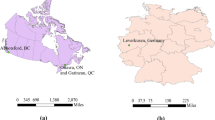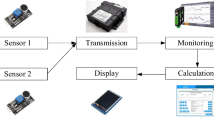Abstract
Continental coverage and year-round operation of the weather radar networks provide an unprecedented opportunity for studying large-scale airborne migration. The broad and local-scale airborne information collected by these infrastructures can answer many ecological questions. However, extracting and interpreting the biological information from such massive weather radar data remains an intractable problem. Recently, many big-data problems have been solved using the deep learning technology. In this study, the biological information in the weather radar data is identified using the advanced deep learning method. The proposed method consists of two main parts, i.e., a rendering and casting procedure and an image segmentation procedure based on a convolutional neural network. The biological data are automatically extracted by rendering and mapping, image segmentation, and result masking. By analyzing the typical radar data from single and multiple stations, we partly reveal the intensity and speed of the migration pattern. We present the first feasibility study of the extraction of local and large-scale biological phenomena from the Chinese weather radar network data.
Similar content being viewed by others

References
van Doren B M, Horton K G. A continental system for forecasting bird migration. Science, 2018, 361: 1115–1118
Kelly J F, Horton K G. Toward a predictive macrosystems framework for migration ecology. Glob Ecol Biogeogr, 2016, 25: 1159–1165
Chilson P B, Frick W F, Stepanian P M, et al. Estimating animal densities in the aerosphere using weather radar: to Z or not to Z? Ecosphere, 2012, 3: 1–19
Rosenberg K V, Dokter A M, Blancher P J, et al. Decline of the North American avifauna. Science, 2019, 366: 120–124
Hu C, Cui K, Wang R, et al. A retrieval method of vertical profiles of reflectivity for migratory animals using weather radar. IEEE Trans Geosci Remote Sens, 2020, 58: 1030–1040
Stepanian P M, Horton K G. Extracting migrant flight orientation profiles using polarimetric radar. IEEE Trans Geosci Remote Sens, 2015, 53: 6518–6528
Hu C, Kong S, Wang R, et al. Identification of migratory insects from their physical features using a decision-tree support vector machine and its application to radar entomology. Sci Rep, 2018, 8: 5449
Hu C, Li W, Wang R, et al. Accurate insect orientation extraction based on polarization scattering matrix estimation. IEEE Geosci Remote Sens Lett, 2017, 14: 1755–1759
Hu C, Li W Q, Wang R, et al. Insect flight speed estimation analysis based on a full-polarization radar. Sci China Inf Sci, 2018, 61: 109306
Hu C, Wang Y X, Wang R, et al. An improved radar detection and tracking method for small UAV under clutter environment. Sci China Inf Sci, 2019, 62: 029306
Krizhevsky A, Sutskever I, Hinton G E. Imagenet classification with deep convolutional neural networks. In: Proceedings of the 25th International Conference on Neural Information Processing Systems, 2012. 1097–1105
Lin T Y, Winner K, Bernstein G, et al. MistNet: measuring historical bird migration in the us using archived weather radar data and convolutional neural networks. Methods Ecol Evol, 2019, 10: 1908–1922
Hu C, Li S, Wang R, et al. Extracting animal migration pattern from weather radar observation based on deep convolutional neural networks. J Eng, 2019, 93: 6541–6545
Chilson C, Avery K, McGovern A, et al. Automated detection of bird roosts using NEXRAD radar data and convolutional neural networks. Remote Sens Ecol Conserv, 2019, 5: 20–32
Xu X F. Construction, techniques and application of new generation doppler weather radar network in China. Eng Sci, 2004, 1: 15–25
Zhu X, Zhu J. New generation weather radar network in China (in Chinese). Meteorolog Sci Tech, 2004, 32
Lakshmanan V, Hondl K, Potvin C K, et al. An improved method for estimating radar echo-top height. Wea Forecast, 2013, 28: 481–488
Bruderer B, Liechti F. Variation in density and height distribution of nocturnal migration in the south of Israel. Israel J Zoology, 2013, 41: 477–487
Rennie S J, Curtis M, Peter J, et al. Bayesian echo classification for Australian single-polarization weather radar with application to assimilation of radial velocity observations. J Atmos Ocean Technol, 2015, 32: 1341–1355
Zhang P, Liu S, Xu Q. Identifying Doppler velocity contamination caused by migrating birds. part i: feature extraction and quantification. J Atmos Ocean Technol, 2005, 22: 1105–1113
Lakshmanan V, Fritz A, Smith T, et al. An automated technique to quality control radar reflectivity data. J Appl Meteor Climatol, 2007, 46: 288–305
Hu G, Lim K S, Horvitz N, et al. Mass seasonal bioflows of high-flying insect migrants. Science, 2016, 354: 1584–1587
Chen L C, Zhu Y, Papandreou G, et al. Encoder-decoder with atrous separable convolution for semantic image segmentation. In: Proceedings of the European Conference on Computer Vision (ECCV), 2018. 801–818
Everingham M, Eslami S M A, van Gool L, et al. The pascal visual object classes challenge: a retrospective. Int J Comput Vis, 2015, 111: 98–136
Abadi M, Agarwal A, Barham P, et al. Tensorflow: large-scale machine learning on heterogeneous distributed systems. 2016. ArXiv: 1603.04467
Browning K A, Wexler R. The determination of kinematic properties of a wind field using doppler radar. J Appl Meteor, 1968, 7: 105–113
Acknowledgements
This work was supported by National Natural Science Foundation of China (Grant No. 31727901). The authors thank Prof. Kongming WU, Dr. Qiulin WU and Haowen ZHANG, Institute of Plant Protection, Chinese Academy of Agricultural Sciences, for their kindly discussion and useful suggestions. The authors thank Dongli WU and Dasheng YANG, Meteorological Observation Center, China Meteorological Administration, for providing Chinese weather radar data.
Author information
Authors and Affiliations
Corresponding author
Rights and permissions
About this article
Cite this article
Cui, K., Hu, C., Wang, R. et al. Deep-learning-based extraction of the animal migration patterns from weather radar images. Sci. China Inf. Sci. 63, 140304 (2020). https://doi.org/10.1007/s11432-019-2800-0
Received:
Revised:
Accepted:
Published:
DOI: https://doi.org/10.1007/s11432-019-2800-0



